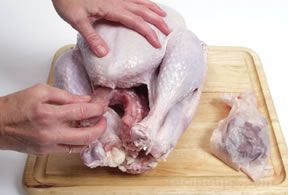|
Thawing
Two common methods of thawing a frozen turkey are the refrigerator method and the cold water method. To properly and safely thaw a turkey, the refrigerator method is recommended. If time is limited, although not recommended, the cold water method is preferred over the temptation of thawing the turkey at room temperature. Thawing turkey at room temperature or in warm water promotes the rapid growth of bacteria.
Refrigerator Thawing
Placing a frozen turkey in the refrigerator is the best and safest method for thawing. The turkey should be kept in its original wrapper during the thawing process. Thawing the bird in the refrigerator may take a long time, especially if the turkey is a large size, but it is absolutely the safest method for thawing. 24 hours for every 5 pounds defrosting time is needed to properly thaw the turkey. This time may vary because of the individual temperature settings of different refrigerators. Also, thawing a turkey in a refrigerator with glass shelves may require a longer thawing time than a refrigerator with wire shelves.
Refrigerator Thawing Time
|
8 to 12 pound
frozen turkey |
13 to 16 pound
frozen turkey |
17 to 20 pound
frozen turkey |
21 to 24 pound
frozen turkey |
|
Allow 2 to 3 days |
Allow 3 to 4 days |
Allow 4 to 5 days |
Allow 5 to 6 days |
Cold Water Thawing
As with thawing in the refrigerator, keep the bird in its original wrapper and immerse in cold water. Make sure the water is very cold and if the original wrapper has any punctures or tears in it, place the turkey in another plastic bag and seal. Place the turkey breast side down and completely cover with cold water. Change the water every 30 minutes. Allow at least 30 minutes defrosting time per pound when using the cold water method. Turkey that has been thawed by the cold water method must be cooked immediately.
Cold Water Thawing Time
|
8 to 12 pound
frozen turkey |
13 to 16 pound
frozen turkey |
17 to 20 pound
frozen turkey |
21 to 24 pound
frozen turkey |
|
Allow 4 to 6 hours |
Allow 6 to 8 hours |
Allow 8 to 10 hours |
Allow 10 to 12 hours |
Cleaning the Turkey
- After the turkey has thawed, remove the packaging.
- The neck and the giblets are usually found inside the body cavity so these can be removed and discarded, or if they are to be used, wash with cold water and pat dry with paper towels. Refrigerate the giblets until ready to use.

- Thoroughly wash the turkey inside and out with cold water and pat dry.

- Season with salt and pepper and with any herbs and spices that are desired, this is optional.
- If the turkey is to be stuffed, the stuffing should be inserted into the body cavity just before the bird will be placed in the oven. It is a dangerous practice to stuff the turkey in advance with the idea that time will be saved. The stuffing may promote the rapid growth of harmful bacteria if the turkey is not cooked immediately after stuffing. Do not overstuff the turkey because the stuffing will expand as it cooks.
- The turkey may be coated with oil or butter to help brown the skin.
Safe Handling Practices
Proper food handling practices must be followed during the preparation of the turkey in order to avoid possible problems with food poisoning.
- The raw turkey, giblets, and their juices should not be allowed to come in contact with any other food item.
- After handling the raw turkey, your hands will be contaminated. Do not touch any other food items and as few surfaces as possible before your hands have been thoroughly washed.
- Cutting boards and utensils must be thoroughly washed after preparing the turkey for the oven.
- Do not place cooked food on the same plate that held the raw food.
- Besides using soap and water for cleaning surfaces, bleach or an antibacterial spray may be used to help kill any organisms that the soap and water missed.
- Do not use a microwave to thaw turkey. Microwaves distribute uneven, therefore unsafe, heat.
- Turkey should remain in the original packaging when thawing. If the original packaging has punctures or tears, place the turkey in another leakproof plastic bag and seal it tightly. If the wrapping is damaged, bacteria from the surrounding environment will contaminate the turkey.
|


